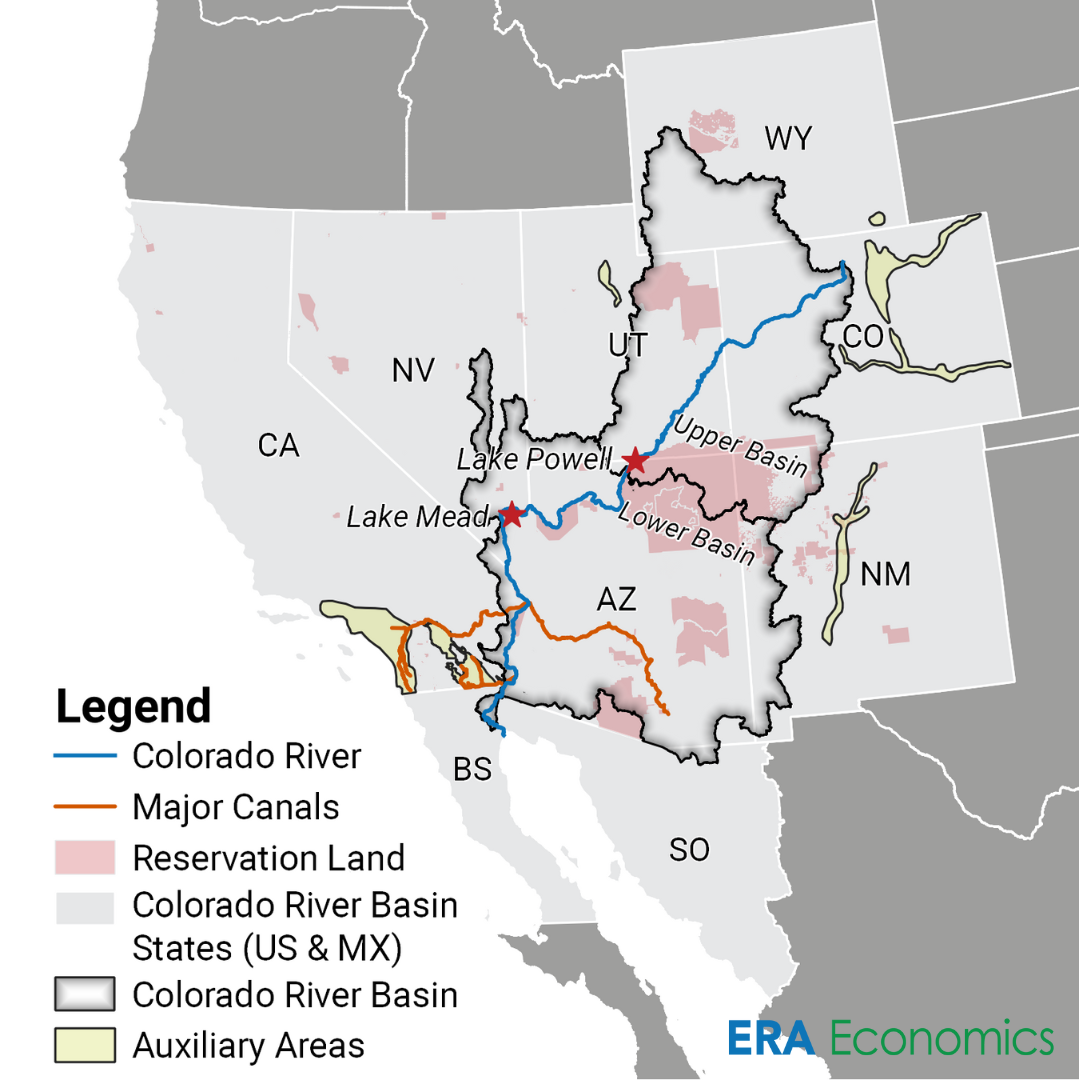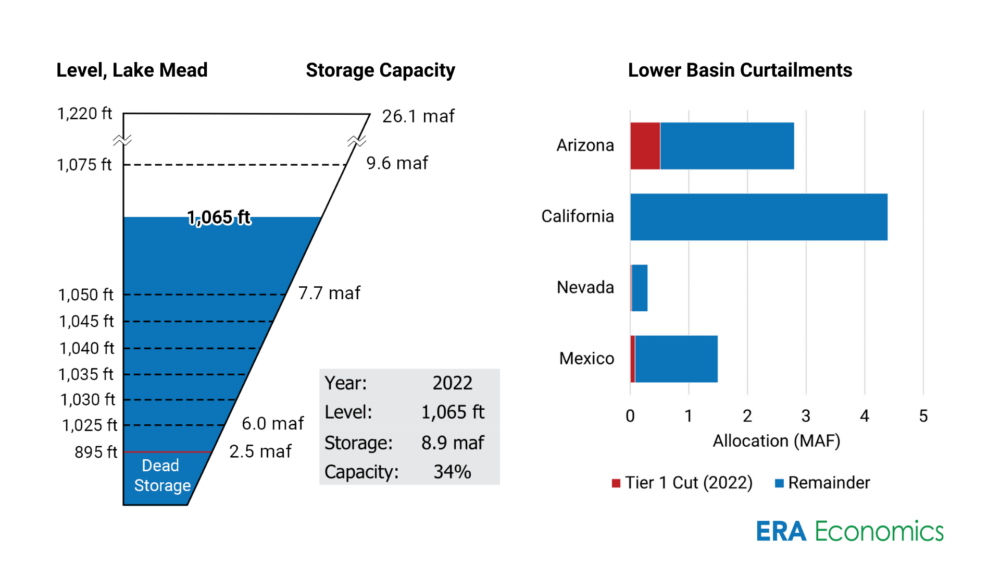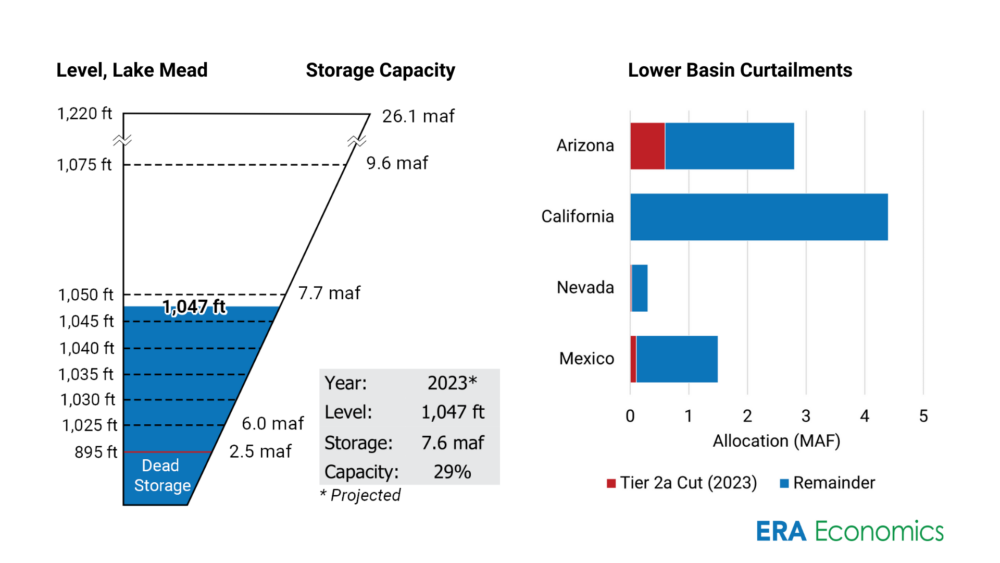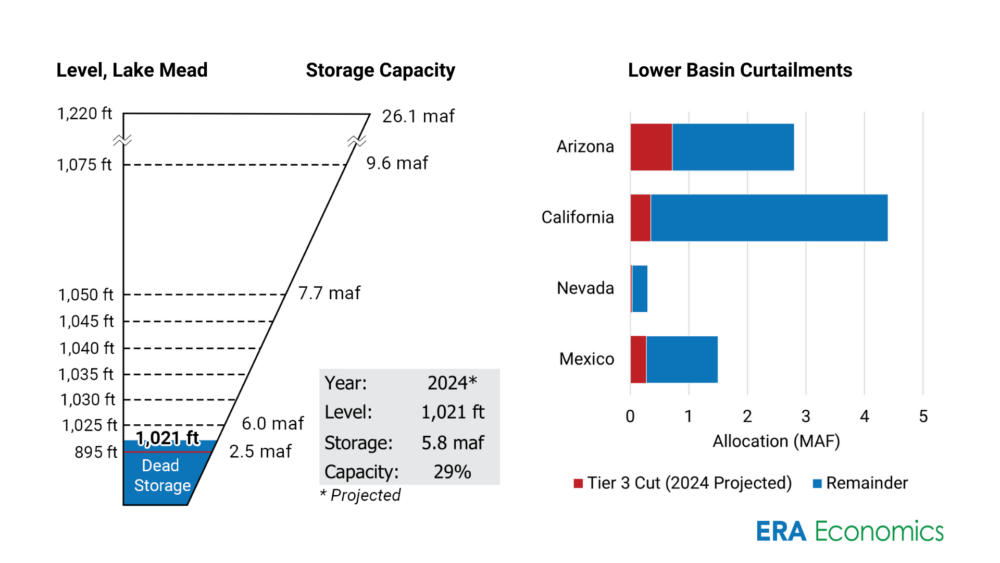Rebalancing the Colorado River Basin: How Much Must Be Cut and What Will It Cost?
The water shortage in the Colorado River Basin (CRB) is one of the biggest stories in western water and will be for years to come. Although many reports have characterized it as caused by drought, it is more accurately a long-term imbalance between available supply and committed or planned diversions.
Background on the Colorado River Basin
A set of laws and agreements collectively known as the Law of the River allocate water among users and uses: among the Upper Basin, Lower Basin, and Mexico; among states within each basin; and according to priorities based on seniority of use and other state and federal laws, agreements, and court decisions. Agreements negotiated among the parties in 2007 and 2019 define how cuts would be assigned under defined shortage conditions, though these agreements expire and must be renegotiated by the end of 2026.
It is now clear that these negotiated cuts will be insufficient to bring the system back in balance, so two questions are foremost. Where can the states find additional cuts? And what will it cost to induce further voluntary cuts? Some groups are recommending that the U.S. Bureau of Reclamation (Reclamation) and/or individual states impose reductions, but the legal authority to do so is unclear and the actions would certainly launch legal challenges. Reclamation released a letter on October 12 indicating that further cuts are likely to be negotiated and compensated through voluntary agreements, at least in the near term.
Several announcements in recent weeks highlight the expenditures of taxpayer money that are at stake. The federal government has established billions of dollars for western drought relief funding that could be used in part to pay growers to reduce water use. So, what is a reasonable expectation for reducing water use further, at what cost, and to whom?
Fallowing crop land results in direct economic impacts to growers in forgone net returns. As the production of forage, winter vegetables, and leafy greens decreases this can increase the price of feed for livestock and dairies, and retail food prices for consumers. It also results in third-party impacts to local farmworkers and businesses including packing, transportation, and farm input suppliers that depend on growers producing crops. These effects are an important secondary economic impact from fallowing programs.
Current Colorado River shortage tier cuts
In August 2021, Reclamation officially announced that the Lower Colorado would be in a Tier 1 shortage in 2022. Based on the agreements negotiated in 2007 and 2019, Arizona took by far the largest cut in Tier 1, about half a million acre-feet (MAF), which was largely borne by Central Arizona Project (CAP) non-tribal irrigation districts.
Reclamation’s August 2022 report resulted in a Tier 2a shortage declaration for 2023. Arizona’s responsibility will increase to nearly 600 thousand acre-feet (TAF). California’s share is not cut in Tier 2a (although California has voluntarily left some water in Lake Mead to postpone shortages for all states), but that will change if shortage levels increase.
Reclamation currently projects a Tier 2b or possibly even Tier 3 shortage for 2024. As Lake Mead elevation drops below 1,045 ft, Arizona’s contribution increases to 640 TAF and California must reduce diversions by 200 TAF initially, increasing by 50 TAF with every additional 5 ft of lake decline up to a maximum of 350 TAF under a Tier 3 shortage. Cuts to Mexico jump to 275 TAF in a Tier 3 shortage.
Reclamation recognizes that the downward trend in lake levels and storage will continue and that the Tier 2a, 2b, and 3 cuts are insufficient to stop or reverse the trend. Commissioner Touton announced in June that Reclamation would use its authority to make further cuts unless the states can devise their own plan. She gave the states until mid-August to create a plan to reduce consumptive use and river diversions by another 2 to 4 MAF. As of this writing the states had not agreed on a plan but are continuing to work. It is unclear to what extent Reclamation will implement its own plans to cut diversions and whether those will be structured as mandatory, uncompensated cuts, voluntary cuts with compensation, or some combination.
So for now, Arizona will bear the brunt of the Tier 2a cut, but the additional cuts the Commissioner is requesting are to postpone or avoid the much larger cuts looming for California urban users and Mexico in 2024 and beyond. Figure 1 illustrates current and projected lake levels and cuts by state.
Where can the Colorado River Basin find additional cuts?
The largest water use in both the Upper and Lower Basins is for irrigation, and a number of these users have high priority so have not yet faced mandatory cuts. Figure 2 shows a few of these in the Lower Basin. A group of large water agencies, including Metropolitan Water District of Southern California (Metropolitan), Central Arizona Water Conservation District, and Southern Nevada Water Authority have been talking with some of these irrigation agencies to reduce their diversions in return for payment. Those talks appear to be continuing.
In a July 18 letter to the Commissioner, the Upper Basin states (Colorado, New Mexico, Utah, and Wyoming) argued that they have more than met their obligation under law and did not commit to voluntary conservation. They recommended re-activating a larger version of Reclamation’s willing-seller pilot programs to pay growers and districts to reduce consumptive use (known as SCPP in the Upper Basin and DSCP in the Lower Basin). However, Reclamation’s summary of SCPP warns that a new such program may be ineffective in getting more water into Lake Powell or Mead, stating “in the absence of legal mechanisms to protect the system conservation water from diversion, it is available for diversion and beneficial use by an Upper Basin Colorado River water user before the system conservation water flows into Lake Powell.”
In early October, California has offered to voluntarily contribute up to 400 TAF, or just less than 10 percent of its river entitlement. The conceptual proposal does not specify how the water would be obtained, including any land fallowing or other efficiency improvements. And it does not specify potential payment terms that would be required to encourage voluntary participation in such a program.
Yesterday, Reclamation issued a letter outlining a new Lower Colorado Conservation and Efficiency Program (LCCP). Compensation ranges from $330 to $400 per AF for a one- to three-year agreement for system conservation. Additional proposals will be accepted and reviewed by Reclamation that may include specific conservation measures and compensation terms with sufficient “economic justification for the price.”

What will it cost to induce further voluntary cuts?
Two organizations representing irrigators in the Lower Basin have publicly suggested their members would offer significant amounts of water but at steep prices. Imperial County Farm Bureau proposed $2,300 per AF for one year’s worth of land fallowing or other conservation measures. Yuma irrigators proposed making up to 1 million AF per year available for a price of $1,500 per AF. Expected compensation terms for the recent offer by California to conserve 400 TAF have not been made public. Reclamation’s new LCCP has just offered $330 to $400 per AF.
There are several recent voluntary conservation programs that exist in the CRB. Given the substantial sums of taxpayer dollars at stake, we conducted a reconnaissance-level review of recent programs across primarily the Lower Basin to establish comparable price ranges:
- The City of Tucson will be compensated $260 per AF, for up to 30 TAF, for leaving its allocation in Lake Mead.
- San Diego County Water Authority has a long-term agreement to pay for on-farm and system efficiency improvements in Imperial Irrigation District in exchange for saved water. Efficiency improvements are more expensive per AF than fallowing, and San Diego’s current payment to Imperial is over $700 per AF. The participating growers get paid less than this, depending on what efficiency measures they adopt.
- From 2015 through 2019, SCPP and DSCP pilot projects contracted for irrigation water conservation at an effective average price between $170 – 180 per AF.
- From 2015 through 2017, Imperial Irrigation District’s (IID) land fallowing program paid growers $175 per AF.
- The latest 2021-22 IID on-farm conservation program has set an overall target of paying $290 per AF to participating growers.
- Coachella Valley Water District’s Colorado River Water Conservation Program is currently offering $200 per AF to its growers willing to forego irrigation, though participation is reportedly low so far.
- Metropolitan has an ongoing land fallowing agreement with Palo Verde Irrigation District that pays growers an upfront amount per acre that gives Metropolitan the right to call on that land’s water for an additional payment. The resulting price per AF depends on actual crops fallowed and how often water is called but is approximately in the $250 – $300 per AF range.
- In Arizona, the Central Arizona Groundwater Replenishment District purchased Long Term Storage Credits for $250 per AF and has leased Central Arizona Project water from various tribes for between $56 and $150 per AF in agreements in 2019 and 2020.
More recent negotiations for additional water from land fallowing are above this range of payment for land fallowing. There is an economic justification for higher prices. Three factors confirm that prices paid will need to be higher than the recent fallowing programs suggest:
- Market Prices. Market prices for hay and other forage, the predominant crops likely to be included in a fallowing program, have been historically high this year, driven by strong domestic and export demand. Alfalfa hay in the San Joaquin Valley is currently selling at $435 per ton, and a grower in Imperial was recently quoted as saying net returns for alfalfa this year are $1,500 per acre.
- New Funding. The recent passage of the reconciliation bill (Inflation Reduction Act) has provided a significant source of funds that may be used for buying water. Potential sellers are aware of this funding.
- Scale. The scale of the program required to meet even Reclamation’s lower target of 2 million AF is vastly larger than anything to date. A greater incentive will be needed to induce more growers and more profitable lands and crops to participate in voluntary land fallowing. And as more land participates in fallowing, market conditions and crop prices improve for lands remaining in production, raising the bar higher.
Urban and coastal regions are already incorporating expensive urban conservation, recycling, and desalinization options into their supply mix, and some of these costs can be avoided or postponed by maintaining supply from the Colorado River. The high cost of alternatives raises the willingness to pay for water from land fallowing. While some water can likely be purchased at prices near to recent programs, say $200 to $400 per AF, the sheer scale of the CRB imbalance and this voluntary program suggests that a more plausible range for voluntary land fallowing under current conditions would be substantially higher, perhaps in the range of $600 to $900 per AF. We recommend additional analysis of the economic justification to establish a plausible range of payments, and how those would vary by region and under different programs.
It is also important to recognize that fallowing cropland can cause additional impacts to farmworkers and other businesses that depend on farming in the region. This includes packing, shipping, farm input suppliers, and downstream industries. In addition, as the supply of winter vegetables, forage, and other crops decreases under a voluntary fallowing program, this can increase prices for buyers and ultimately for consumers. These secondary economic impacts can be evaluated as part of program development.
What are some recommended principles?
Drought is affecting numerous areas in the West and is likely to continue. It is important to develop long-term solutions that work, both at scale and over time. In our view, the recommended principles for pursuing land fallowing or other conservation agreements are:
Commit to stewardship. Remember that federal dollars are funded by U.S. taxpayers, and commit to being good stewards of taxpayer money. How can we do that?
- Start with an estimate of the value of irrigation water as a baseline to understand the lower bound of cost to acquire water and how that cost rises as more water is acquired. This can avoid some of the excitement around federal funding and puzzlingly high opening bids.
- Evaluate the true marginal cost curve using observed prices in recent programs initiated by Metropolitan, San Diego, Imperial, and others. This would establish a reasonable range of per-AF payments under different levels of cuts.
- Understand that the value of water in production increases as acquisitions move into higher valued lands and crops. Due to the potential scale of the program, expect prices paid to voluntary sellers to be higher than in recent, smaller programs.
Set the right metrics. In addition to cost-effectiveness, developing other appropriate measurements for success will be necessary, such as quantifying water savings, or sharing the regional burden of water savings. How can we do that?
- Concentrate on reducing consumptive use as opposed to pursuing increased efficiency for its own sake. Most “losses” from the transport and use of irrigation water end up providing water for other uses. Paying to reduce canal seepage and irrigation return flow impacts these other uses. For example, the loss of return flow to the Salton Sea from Imperial transferring conserved water to San Diego has substantially contributed to the Sea’s decline, with restoration now estimated to cost over $9 billion.
- Break the Basin into regions (at least by state) so that water acquisitions can be spread geographically if politically or hydrologically desirable.
- Consider expanding the purchase program to include Mexico’s share if legally possible or desired.
- Consider secondary economic impacts of a large-scale program that would idle cropland. The Lower Basin produces forage that is a critical input for the domestic dairy and livestock industries and a mix of vegetables and leafy greens that are part of our domestic food supply. Secondary economic impacts from the farm to the final consumer are not factors that influence direct payments to growers but are real impacts to local communities.
Design for durability. Develop voluntary conservation programs and payment structures that create lasting relationships and durable programs, as the long-term imbalance is unlikely to get better. How can we do that?
- Look for long-term deals, even permanent retirement, and expect to adjust the program over time.
- To be a viable long-term solution, payments need to transition away from single-year deals that pay for stranded capital investments.
- Leverage the experience and influence of other Lower Basin water users to negotiate fair deals and robust agreements for all parties.
Takeaway
Ideas presented here focus on near-term actions to reduce consumptive use in the Lower Basin. A long-term solution requires all Basin states and users to collaborate. Components of the solution include identifying how to incentivize and protect water savings in the Upper Basin, converting short-term savings to long-term savings agreements, renegotiating a drought contingency plan, and rethinking some of the allocations and rules embedded in the Law of the River.
Time is running out for the parties to strike an agreement. If only a small portion of the target savings can be achieved and the lake levels continue to decline, even more serious cuts will be coming in only a few years. If the voluntary approach does not work or only addresses a small part of the imbalance, calls for more onerous actions will increase. Basin-wide, commitments to stewardship, measurement, and durability are needed to avoid such outcomes.
If you’re interested to talk more about the Colorado River Basin shortages and related economic impacts, reach out to Steve Hatchett.






